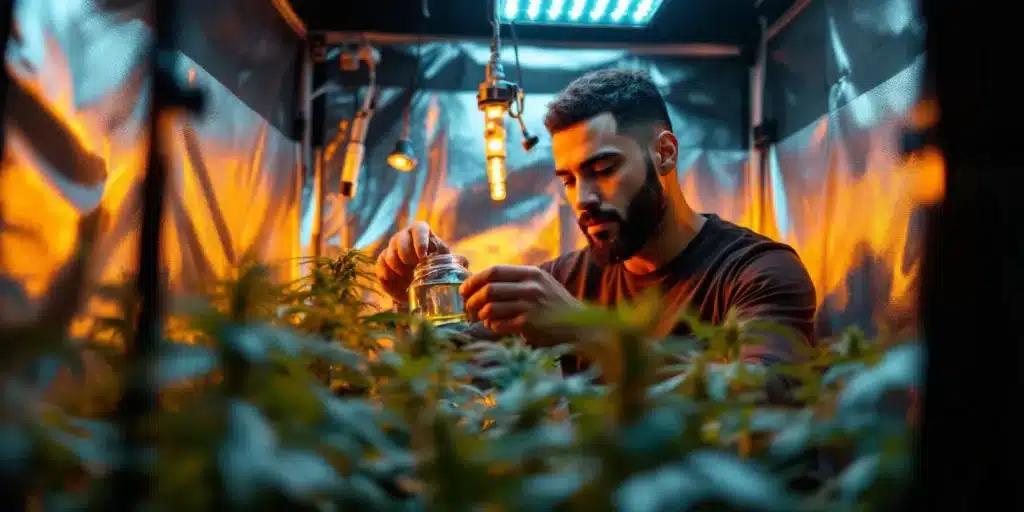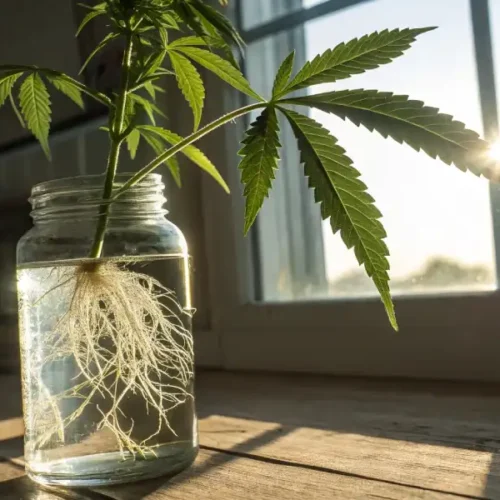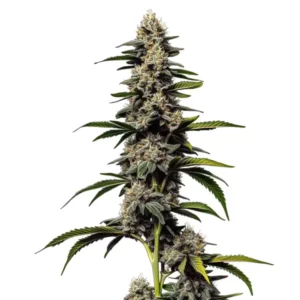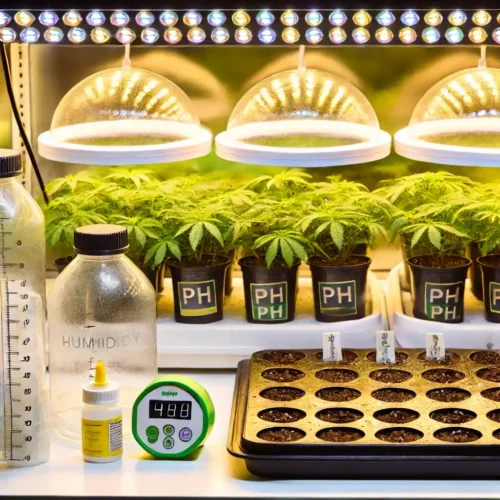When growing cannabis, many factors can determine your plant’s success, but one of the most overlooked is PPM (parts per million). Getting the ideal ppm for cannabis plants levels right can make the difference between a healthy, thriving plant and one that struggles to grow. Let’s dive into why PPM matters and how you can optimize it for your cannabis grow.
Knowing PPM and Its Importance in Cannabis Growing
Maintaining the right ppm for weed plants levels is essential for keeping your cannabis plants well-nourished and healthy. PPM measures the concentration of nutrients in your water. Too much or too little can cause your plants to suffer, and finding the sweet spot for the ideal PPM cannabis ensures balanced nutrient absorption.
What is PPM and Why Does It Matter?
PPM stands for parts per million and refers to the total concentration of dissolved solids (nutrients and minerals) in your water. In cannabis growing, PPM is critical because it directly impacts how your plants absorb nutrients. If your PPM is too high, your plants can experience nutrient burn; if too low, they may not get enough nutrients to support healthy growth.
Achieving the ideal PPM cannabis allows your plants to thrive by ensuring they receive the right nutrient levels at each stage of growth. Realizing how to measure and adjust PPM is key to producing robust plants and maximizing yields.
How PPM Affects Nutrient Absorption in Cannabis
PPM directly influences how well cannabis plants can absorb nutrients. When the nutrient solution is too concentrated, the roots can become overwhelmed, leading to nutrient lockout. On the other hand, if the solution is too diluted, the plant may not receive enough essential nutrients to grow effectively. Maintaining the ideal PPM cannabis levels throughout the growing cycle ensures that the plants can easily absorb what they need without stressing the root system.
Monitoring PPM helps prevent nutrient deficiencies and toxicity, allowing your cannabis to grow at its best. Knowing how PPM works is a simple yet powerful tool in your growing arsenal, ensuring each plant gets exactly what it needs.
PPM in Hydroponic vs. Soil Grows
The growing medium you choose impacts how you manage PPM levels. For hydroponic grows, PPM monitoring is even more critical since all the plant’s nutrients come from the water. Hydroponic systems require precise adjustments to maintain the ideal PPM cannabis levels, as the plants directly rely on this for their nutrition.
In soil, while PPM monitoring is still valuable, the soil itself acts as a buffer and stores nutrients. You may not need to adjust PPM levels as frequently, but maintaining balance is still key. Whether you’re growing in soil or hydroponics, knowing how PPM interacts with your growing medium helps you avoid common problems and keep your plants flourishing.
Promos & Deals
Ideal PPM Levels for Different Cannabis Growth Stages
The ideal PPM cannabis varies depending on the stage of growth your plant is in. From seedlings to flowering, each phase has different nutrient needs, and monitoring PPM ensures that you are providing the right balance of nutrients at every step.

PPM Levels During the Seedling Stage
At the seedling stage, cannabis plants are incredibly sensitive, and their nutrient needs are minimal. The ideal PPM cannabis at this early stage should be low, around 100-250 PPM. Overloading seedlings with nutrients can cause damage, so it’s important to keep things light during these initial weeks.
Watering with a low PPM helps establish strong roots without overwhelming the plant. Regularly checking the PPM during the seedling stage ensures that your young plants aren’t exposed to too much nutrient content, giving them a better chance to grow into healthy, strong plants.
PPM Levels During Vegetative Growth
As your cannabis enters the vegetative stage, its nutrient requirements increase. The ideal PPM cannabis during this phase ranges from 500 to 1,000 PPM, depending on the strain and growing conditions. This is when the plant focuses on developing strong stems and leaves, and higher nutrient concentrations are necessary to support this rapid growth.
Regular monitoring of your PPM levels during the vegetative stage helps prevent nutrient burn or deficiency. Adjust your nutrient solution gradually to maintain the balance, ensuring the plant gets what it needs to thrive during this critical growth phase.
PPM Levels During the Flowering Stage
During the ppm flowering stage, cannabis plants require a higher concentration of nutrients to produce buds. The ideal PPM cannabis at this stage should range from 1,000 to 1,600 PPM. This is when your plants need the most support, as they are focusing on producing flowers, and proper nutrient management is important for a successful harvest.
Be cautious not to overfeed during this phase, as excessively high PPM can lead to nutrient burn, which will affect the quality of your final yield. Monitoring and adjusting PPM during the flowering stage helps you maximize bud production while avoiding nutrient stress.
Adjusting PPM for Different Cannabis Strains
Different cannabis strains have varying nutrient needs, so the ideal PPM cannabis might differ depending on the type of plant you’re growing. Some strains, especially heavy-feeding sativa or hybrid varieties, might require higher PPM levels during their growth phases. In contrast, more delicate indica strains may need lower PPM levels to avoid nutrient overload.
Customizing your nutrient solution based on strain specifics is an excellent way to optimize plant health. By regularly adjusting your PPM to match the unique needs of your strain, you ensure that your plants get exactly what they need, preventing unnecessary stress and boosting overall yields.
How to Measure and Adjust PPM in Cannabis Cultivation
Maintaining the ideal PPM cannabis levels requires regular monitoring and fine-tuning throughout the growth cycle. Fortunately, measuring and adjusting PPM is a straightforward process once you know the tools and techniques.
Tools for Measuring PPM Accurately
To measure PPM, you’ll need a digital PPM meter. These devices are easy to use and provide real-time data on the concentration of dissolved solids in your nutrient solution. By dipping the probe into the water or nutrient mix, the meter will display the current PPM level, allowing you to adjust accordingly.
Using a high-quality PPM meter is essential for accuracy. Cheap or unreliable meters can give incorrect readings, which could lead to overfeeding or nutrient deficiencies. Investing in a reliable meter ensures that you can maintain the ideal PPM cannabis levels without guesswork.
Adjusting PPM by Changing Nutrient Concentrations
Once you have your PPM reading, adjusting your nutrient solution is simple. If the PPM is too high, you can dilute the solution by adding more water. If the PPM is too low, adding more nutrients will increase the concentration. It’s important to make gradual changes to avoid shocking your plants with sudden nutrient imbalances.
Regular adjustments are a normal part of maintaining the ideal PPM cannabis throughout the growth cycle. Always make small changes and observe how your plants respond before making further adjustments.
Monitoring Water Quality and Its Impact on PPM
The quality of the water you use has a direct effect on your PPM levels. Tap water, for example, often contains minerals and chemicals that can raise the PPM before you’ve even added nutrients. If your tap water has a high PPM, it might be best to use filtered or distilled water to maintain better control over your nutrient solution.
By keeping your water clean and free from contaminants, you ensure that you can manage the ideal PPM cannabis with greater accuracy. Checking the PPM of your water before adding nutrients helps you maintain precise control over your feeding schedule.
nutrient mix and gradually increase the concentration as your plants recover. Regularly scheduled flushing can help prevent nutrient buildup and keep PPM levels stable throughout the grow cycle.

Tips for Maintaining Ideal PPM Levels for Cannabis
Keeping your PPM levels in check requires more than just adjusting nutrients when issues arise. By following best practices and consistently monitoring your grow, you can maintain the ideal PPM cannabis levels and ensure healthier plants throughout every stage of growth.
Balancing Nutrients for Optimal PPM
Balancing your nutrient solution is key to maintaining ideal PPM levels. It’s important to use a nutrient mix that is designed specifically for cannabis, as this will provide the right balance of macro and micronutrients. Avoid using fertilizers that are not intended for cannabis, as they can cause imbalances and lead to high or low PPM levels.
To achieve the ideal PPM cannabis, regularly measure the PPM before and after adding nutrients to your water. This allows you to track how your plants are responding to the feeding schedule and make adjustments if necessary. By carefully balancing your nutrients, you can prevent nutrient lockout and ensure optimal growth.
Regular PPM Monitoring for Healthier Plants
Regular monitoring is the foundation for maintaining the ideal PPM cannabis. By checking your PPM levels consistently, you can catch any imbalances before they become serious problems. It’s a good practice to measure PPM at least once a week during each growth stage and make adjustments as needed.
Using a reliable PPM meter helps you avoid guesswork, ensuring that your plants receive the correct amount of nutrients. Staying on top of your PPM levels will reduce the risk of nutrient burn, deficiencies, and other growth issues, keeping your cannabis plants healthy and productive.
Preventing Nutrient Lockout with Correct PPM Levels
Nutrient lockout occurs when the PPM levels are too high, preventing the plant from absorbing essential nutrients. Even if the nutrients are present in the water, the plant is unable to use them because of an imbalance in the root zone. This often leads to symptoms like yellowing leaves and stunted growth.
To prevent nutrient lockout, regularly monitor PPM levels and perform periodic flushes to remove any buildup in the root zone. Maintaining the ideal PPM cannabis allows your plants to access the nutrients they need, avoiding the common pitfalls that come with nutrient lockout. Consistent care and monitoring go a long way in ensuring your plants remain healthy and capable of reaching their full potential.
Long-Term Strategies for Maintaining Ideal PPM Levels in Cannabis
Growing cannabis is a long-term commitment, and maintaining the ideal PPM cannabis levels requires consistent care, ongoing monitoring, and the use of proper strategies throughout the entire growing process. When you implement long-term strategies, you help to ensure your plants stay healthy, productive, and free from nutrient-related issues.

Creating a PPM Maintenance Schedule
A structured PPM maintenance schedule can make it easier to keep your plants in the ideal nutrient range. During each stage of growth, from seedlings to the flowering phase, the nutrient needs of cannabis plants change. A schedule that includes regular PPM measurements, nutrient feedings, and adjustments will help ensure your plants get what they need at the right time.
The schedule should be based on your specific grow setup, whether you’re working with hydroponics or soil, as well as the specific strains you are growing. Checking PPM at least weekly, or even more frequently if needed, gives you the opportunity to catch imbalances early and adjust before problems arise. Over time, following a consistent schedule becomes second nature, allowing you to maintain ideal PPM cannabis levels easily.
Choosing the Right Nutrients for Long-Term Success
The nutrients you choose for your cannabis plants play a huge function in maintaining the correct PPM levels. High-quality, cannabis-specific nutrient solutions are formulated with the right balance of macronutrients and micronutrients, making it easier to stay within the ideal PPM cannabis range without the risk of nutrient overload or deficiency.
Look for nutrient brands that are well-regarded in the cannabis growing community and designed to meet the needs of your particular growing method (hydroponics, soil, etc.). Whether you are using organic nutrients or chemical-based solutions, make sure you are following feeding instructions closely and adjusting based on your PPM readings to ensure balance.
Water Quality in Maintaining Ideal PPM
One of the most overlooked aspects of PPM management is water quality. Since PPM measures the concentration of dissolved solids in your water, the base water you use can significantly affect PPM levels before any nutrients are added. Knowing how your water quality affects nutrient delivery is essential to maintaining ideal PPM cannabis levels.
Using Filtered or Distilled Water for Better Control
If your tap water contains a lot of dissolved minerals or additives like chlorine, it can raise the PPM before you even add your nutrient mix. This can make it difficult to manage nutrients accurately, as the high starting PPM means you’ll have less room to add the necessary nutrients without risking overfeeding. To prevent this, many growers choose to use filtered or distilled water.
Filtered water removes impurities, giving you greater control over the nutrients you add and helping you achieve the ideal PPM cannabis levels more easily. Distilled water is even purer, containing almost no dissolved solids, which allows you to start from a clean slate every time. Using high-quality water makes it easier to keep your nutrient solution in the correct range and ensures your plants get exactly what they need without interference.
Testing and Adjusting pH for Accurate PPM Management
pH levels and PPM are closely related, and keeping your pH in check is important for maintaining ideal nutrient levels. If your pH is too high or too low, it can prevent your plants from absorbing the nutrients they need, even if your PPM levels are perfect. This creates a situation where nutrient lockout occurs, leading to deficiencies and poor growth.
Testing your pH regularly and adjusting as needed is a key step in achieving the ideal PPM cannabis range. For soil grows, a pH range of 6.0 to 7.0 is generally recommended, while hydroponic systems usually require a slightly lower pH of 5.5 to 6.5. Maintaining the correct pH levels ensures your plants can access the nutrients in your solution, allowing PPM management to be more effective.
Troubleshooting PPM Issues for Cannabis Growers
Even with diligent monitoring and adjustments, PPM-related issues can still arise. Troubleshooting common PPM problems is an important skill for every cannabis grower, and knowing how to identify and resolve these issues can keep your plants on the path to success. When ideal PPM cannabis levels fluctuate unexpectedly, it’s important to act quickly to prevent long-term damage.
Identifying Signs of Nutrient Imbalance
The first step in troubleshooting PPM issues is identifying the signs of nutrient imbalance. Visual symptoms like yellowing leaves, burnt tips, or stunted growth are often the result of incorrect PPM levels. If your plants are showing signs of nutrient burn, your PPM is likely too high, whereas signs of deficiency could mean your PPM is too low.
To resolve these issues, start by measuring the PPM of your nutrient solution and comparing it to the recommended levels for your plant’s current growth stage. Adjust accordingly by either diluting the solution or adding more nutrients until you reach the ideal PPM cannabis level. Quick action prevents these symptoms from progressing and helps restore your plants to full health.
Flushing Your Plants to Reset PPM
When PPM levels are too high, flushing your plants is one of the best ways to reset nutrient levels and bring your plants back to balance. A flush involves watering your plants with plain, pH-balanced water to wash away excess salts and nutrients from the growing medium. This process helps clear out any buildup that might be preventing your plants from absorbing the nutrients they need.
After flushing, recheck your PPM levels to ensure they’ve dropped to an acceptable range. Gradually reintroduce nutrients as your plants recover, starting with a lower concentration and slowly increasing until you’re back in the ideal PPM cannabis range. Flushing is especially useful for resolving nutrient lockout or recovering from overfeeding.
Maximizing Yields with Ideal PPM Cannabis Management
For cannabis growers, maximizing yield is always the goal. One of the most effective ways to ensure a bountiful harvest is by managing your PPM levels throughout the growing cycle. Consistently maintaining ideal PPM cannabis levels ensures that your plants receive the nutrients they need at every stage of growth, leading to healthier plants and bigger buds.
Dialing in PPM for Bigger Buds
During the flowering stage, cannabis plants need higher concentrations of phosphorus and potassium to produce large, dense buds. Monitoring PPM closely during this stage allows you to fine-tune your nutrient solution to support maximum bud growth. Keeping your PPM in the ideal range will prevent nutrient deficiencies or excesses that can hinder bud development.
By adjusting PPM gradually and ensuring that your plants have access to the right nutrients, you can encourage larger, more potent buds. For the best results, track your PPM closely and make adjustments based on your plants’ needs, ensuring that they have everything required to thrive during this critical phase.
Monitoring PPM for Healthier Roots and Faster Growth
Maintaining the ideal PPM cannabis levels isn’t just about the buds; it also has a direct impact on root health and overall plant growth. Healthy roots are essential for nutrient uptake, and when PPM levels are in the correct range, the roots can absorb nutrients efficiently. This leads to faster, more vigorous growth, which in turn results in a healthier, stronger plant.
Keeping PPM levels balanced throughout the vegetative stage ensures that your plants develop a strong root system capable of supporting the heavy nutrient demands of the flowering phase. By focusing on root health, you set your plants up for long-term success and improved yields.
















